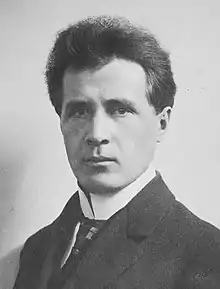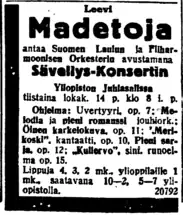Kullervo (Madetoja)
Kullervo, Op. 15, is a symphonic poem (sinfoninen runoelma) for orchestra written in 1913 by Finnish composer Leevi Madetoja.[1] The piece premiered on 14 October 1913 with Madetoja conducting the Helsinki Philharmonic Society.[2]
| Kullervo | |
|---|---|
| Symphonic poem by Leevi Madetoja | |
 The composer (c. 1915–1918) | |
| Opus | 15 |
| Composed | 1913 |
| Publisher | Suomen Säveltäjät (1947) |
| Duration | Approx. 14 minutes[lower-alpha 1] |
| Premiere | |
| Date | 14 October 1913 |
| Location | Helsinki, Finland |
| Conductor | Leevi Madetoja |
| Performers | Helsinki Philharmonic Society |
Background
Composition
Although Madetoja belonged to national romantic movement in Finland, he did not—unlike many of the movement's artists and composers, such as Akseli Gallen-Kallela and Jean Sibelius—often turn to the Kalevala as a source of inspiration.[1] Indeed, Kullervo is Madetoja's only notable composition after the national epic. Madetoja was the fourth composer to tackle the subject of Kullervo.[3] First, in 1860, Filip von Schantz wrote the Kullervo Overture (Kullervo-alkusoitto), which he had intended as the prelude to an opera; this piece premiered the same year in Helsinki at the opening of the Swedish Theatre.[4] Second, in 1880, Robert Kajanus composed and premiered in Leipzig Kullervo's Funeral March (Kullervon surumarssi); though Wagnerian in its chromaticism, it makes use of the Finnish folk song O Mother, so pitiable and poor! (Voi äiti parka ja raukka!).[5] Finally, in 1892, Jean Sibelius composed and premiered in Helsinki the choral symphony Kullervo, for baritone, soprano, mixed chorus, and orchestra; however, Sibelius withdrew his Kullervo in 1893, and therefore, it could not have served as a model for Madetoja;[1] it is also unlikely that he was familiar with the pieces by von Schantz and Kajanus.[3] Instead, the most readily-available Kalevala-themed examples would have been Sibelius's Lemminkäinen Suite (from which two numbers, The Swan of Tuonela and Lemminkäinen's Return, had been published in 1900) and Pohjola's Daughter.[3]
Premiere
Kullervo premiered on 14 October 1913 with Madetoja conducting the Helsinki Philharmonic Society.[2] It was the final number on a program that also included other orchestral novelties by Madetoja: the Concert Overture (Konserttialkusoitto; Op. 7, 1911); Melody and Little Romance (Melodia ja Pieni romanssi; Op. 17, 1913); Dance Vision (Tanssinäky; Op. 11; 1911); Merikoski, a cantata for mixed choir and orchestra to text by V. A. Koskenniemi (Op. 10, 1911); and the original three-movement version of the Little Suite (Pieni sarja; Op. 12, 1913).[lower-alpha 2]
Instrumentation
Kullervo is scored for the following instruments:
- Woodwinds: piccolo, 2 flutes, 2 oboes, 2 clarinets (in A), bass clarinet (in A), and 2 bassoons
- Brass: 4 horns (in F), 2 trumpets (in C), 3 trombones, and tuba
- Percussion: timpani, triangle, cymbals, bass drum, tambourine, and castanets
- Strings: violins, violas, cellos, double basses, and harp
Association of Finnish Composers (Suomen Säveltäjät ry) published the symphonic poem in 1947; Fennica Gehrman is the current distributor.
Recordings
The sortable table below lists commercially available recordings of Kullervo:
| Conductor | Orchestra | Rec.[lower-alpha 3] | Time | Recording venue | Label | Ref. |
|---|---|---|---|---|---|---|
| Leif Segerstam | Finnish Radio Symphony Orchestra | 1981 | 14:07 | Yle's Helsinki studios | Finlandia | |
| Arvo Volmer | Oulu Symphony Orchestra | 1998 | 14:03 | Madetoja Hall, Oulu Music Centre | Alba | |
| John Storgårds | Helsinki Philharmonic Orchestra | 2012 | 14:13 | Helsinki Music Centre | Ondine | |
| Dima Slobodeniouk | Lahti Symphony Orchestra | 2020 | 14:01 | Sibelius Hall | BIS |
Notes, references, and sources
- Notes
- Although the published score lists 18 minutes as Kullervo's estimated duration, all four commercial recordings last 14 minutes. This article utilizes the latter.
- The Little Suite and Melody and Little Romance were arrangements for orchestra of pieces Madetoja had written for solo piano: respectively, Six Pieces for Piano (Op. 12, 1911–1913) and Piano Pieces (Op. 17, 1912). Finally, Dance Vision premiered under its original title, Night Revels (Öinen karkelokuva).
- Refers to the year in which the performers recorded the work; this may not be the same as the year in which the recording was first released to the general public.
- L. Segerstam–Finlandia (FACD 015) 1991
- A. Volmer–Alba (ABCD 211) 2006
- J. Storgårds–Ondine (ODE 1212–2) 2013
- D. Slobodeniouk–BIS (BIS–2371) 2021
- References
- Korhonen 2013, p. 4.
- Hufvudstadsbladet, No. 281 1913, p. 7.
- Korhonen 2021, p. 5.
- Goss 2003, pp. 54–55.
- Goss 2003, p. 55.
- Sources
- Liner notes
- Häyrynen, Antti (2006). Madetoja Orchestral Works 5: "A Sea of Stars" (booklet). Translated by Sinisalo, Susan. Arvo Volmer & Oulu Symphony Orchestra. Alba. p. 10–13. ABCD 211. OCLC 70821917
- Korhonen, Kimmo [in Finnish] (2013). Leevi Madetoja: Symphony No. 2 / Kullervo / Elegy (booklet). Translated by Mäntyjärvi, Jaakko. John Storgårds & Helsinki Philharmonic Orchestra. Ondine. p. 4–6. ODE 1212–2. OCLC 823893771
- Korhonen, Kimmo (2021). Scenes from the Kalevala: Klami / Sibelius / Madetoja / Pylkkänen (booklet). Translated by Barnett, Andrew. Dima Slobodeniouk & Lahti Symphony Orchestra. BIS. p. 4–8. BIS–2371. OCLC 1310081704
- Journals and magazines
- Goss, Glenda Dawn (2003). "A Backdrop for Young Sibelius: The Intellectual Genesis of the Kullervo Symphony". 19th-Century Music. University of California Press. 27 (1): 48–73. JSTOR 10.1525/ncm.2003.27.1.48.
- Newspaper articles (by date)
- BIS [Wasenius, Karl] [in Finnish] (15 October 1913). "Leevi Madetojas kompositionskonsert" [Leevi Madetoja's composition concert]. Hufvudstadsbladet (in Swedish). No. 281. p. 7.
- O. K. [????] (15 October 1913). "Leevi Madetojan sävellyskonsertti" [Leevi Madetoja's composition concert]. Helsingin Sanomat (in Finnish). No. 240. p. 6.
- R e. [Elmgren, Robert] [in Finnish] (15 October 1913). "Leevi Madetojas kompositionskonsert" [Leevi Madetoja's composition concert]. Nya Pressen (in Swedish). No. 237. p. 4.
- E. K. [Katila, Evert] [in Finnish] (16 October 1913). "Leevi Madetojan sävellyskonsertti" [Leevi Madetoja's composition concert]. Uusi Suometar (in Finnish). No. 241. p. 5.

